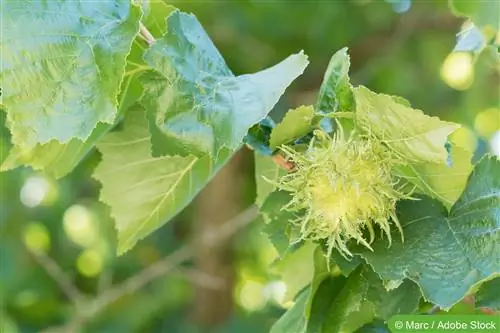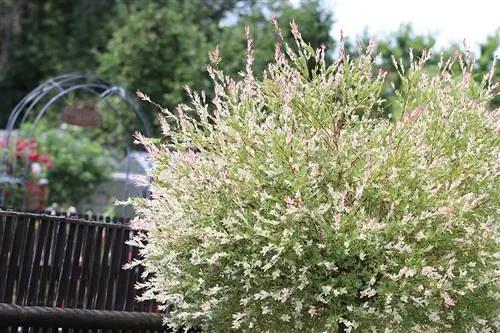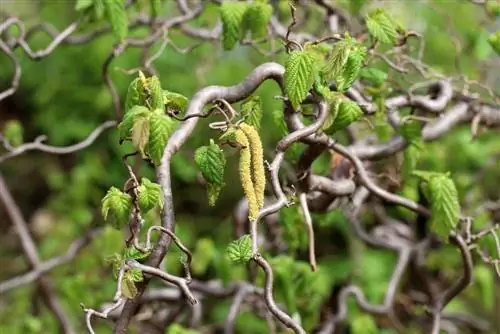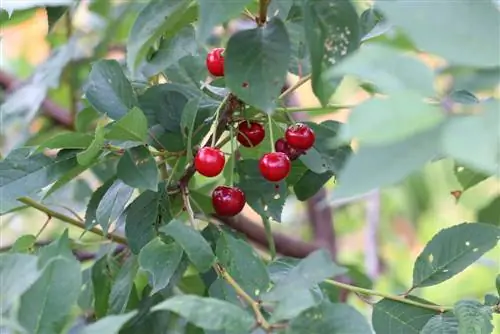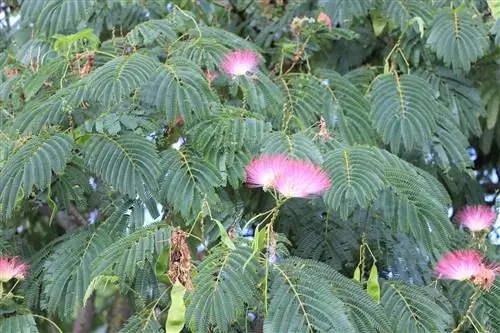- Author admin [email protected].
- Public 2023-12-17 03:39.
- Last modified 2025-06-01 06:48.
The tree hazel should not be confused with the common hazel, because the tree hazel originally comes from southeastern Europe and is widespread in the Himalayan region. Visually, the two species hardly differ in this country; you can only tell the difference in the fruits. The tree hazel has significantly more fruit, but these are surrounded by a much harder shell. It is usually not planted in the garden as a tree for nut harvesting, but only for decoration, as releasing the fruit is too time-consuming. Like its native relatives, the tree hazel has little demands on its location; all that is required is regular pruning so that the hazel does not spread uncontrollably.
Profile
- German name: Tree hazel
- Scientific name: Corylus colurna
- Family: Birch family (Betulaceae)
- Genus: Hazel (Corylus)
- Flowering time: February to March
- Flower color: red (female), yellow (male)
- Fruits: Nuts
- Growth height: up to 20 m
- Frost hardness: up to - 20°C
Location
The tree hazel is very undemanding when it comes to its location. It thrives in both sun and shade or partial shade. However, in order for it to develop well, it should not be too shady and should be planted in a partially shaded location. When choosing a location, care should also be taken not to plant it too close to a property line, as it can develop into widths, especially without regular pruning.
Tip:
The tree hazel is a popular park tree and can also be planted in the garden in company with other trees.
Floor
The tree hazel is a survivor and thrives in almost any location. The substrate can be normal garden soil. It also tolerates sandy soils very well, and moist soils are no problem for it. It just doesn't tolerate constant moisture very well, which is why it shouldn't be planted in the immediate vicinity of a pond. The planting substrate can be prepared with humus and some gravel before planting out the tree hazel. The tree hazel can also occasionally be found in higher areas with calcareous soil. When adding lime, however, care should be taken to use it sparingly and check whether the soil is not already slightly calcareous.
Fertilizing and watering
The tree hazel should only be watered in the first few weeks after planting, but waterlogging should not occur. Normally, the tree hazel does not need to be watered additionally throughout the year, as normal rain is completely sufficient for it. Only in a very dry summer can the ground around the hazel tree be watered, although care must be taken to water thoroughly as the tree forms a deep taproot. Although the tree hazel likes to have a lot of nutrients, normal mulching or adding compost in the spring is sufficient to meet its nutrient needs.
Tip:
Water regularly, even in the first few years, this accelerates the growth of the hazel tree.
pruning
The hazel tree actually shouldn't be cut, but regular pruning is essential for rejuvenation and to reduce its spread.
- Pruning is done in autumn or winter after most of the fruit has fallen off.
- Pruning is also possible in early spring, but before the tree is in the “juice”.
- The incision sites must be professionally closed with tree wax as it can take years until the wound is closed.
- Do not remove side shoots directly on the trunk, but leave them about 10 cm so that no infections can form.
- Dead or diseased plant parts should be removed regularly.
Wintering
The tree hazel does not need any protection in winter and can tolerate severe frost without any problems. The trunk should only be protected from frost in extreme frosts of around -15 °C. In addition, the roots of young trees can be protected with a thick layer of mulch in winter. However, the tree must still be able to breathe due to winter protection, which is why foil or similar materials are unsuitable as protection and can even lead to the death of the tree. Anyone who has ever touched the bark and leaves of the hazel tree will quickly notice that they are rough and almost unpleasant to touch. Therefore, the tree is not a special treat for animals in winter and is avoided, which is why it does not need to be protected from being bitten by wild animals.
Diseases and pests
The tree hazel is hardly susceptible to diseases or pests. Only in isolated cases can fungi form on the tree, but they cannot be dangerous. If they disturb the appearance, branches can be removed without any problems. You just need to be careful with mushrooms directly on the main trunk, as they are usually not that easy to remove without damaging the tree. However, the tree fungi fall off again over the years or can be easily broken off. Aphids can occasionally be found on the tree hazel. If the infestation is not too large, no measures need to be taken. Only if the louse infestation becomes too severe should suitable pesticides be used. The louse infestation can often be traced back to surrounding ant nests. In this case, the ant nest should be combated first, otherwise a new infestation of lice may quickly occur.
Verticillium wilt can very rarely affect tree hazel. This is a fungal disease that first affects the roots and then the entire tree. Since the infestation is only noticed very late and the disease takes its course from within, no countermeasures can be taken. In this case the tree can only be felled. In addition, another tree hazel should not be planted at this location, as this can also quickly be attacked by the fungus again.
Frequently asked questions
Is the tree hazel poisonous?
No. Like its native relative, the tree hazel is not poisonous. The fruits could also be eaten, but are usually too difficult to remove.
Can the tree hazel be planted in a natural garden?
Yes. The tree hazel can easily be planted in a natural garden. Their fruits are also often eaten by local wild animals such as squirrels, which, with a bit of luck, will also come into your own garden.
Is the tree hazel suitable for a hedge?
No. The tree hazel is not suitable for a hedge and should be cut as little as possible. However, the young branches can be easily bent into shape, which is why they can be given a direction of growth, at least in the first few years.
What you should know about the tree hazel in brief
Use of the fruits?
- The nuts are a little smaller compared to the common hazel, which is a shrub, and don't taste as good.
- Nevertheless, tree hazels are specifically cultivated in some countries and the nuts are used there primarily for baking.
- But the wood of the hazel tree is also valuable. It is light brown in color and is made into furniture and carvings.
Susceptibility to disease?
- A newly planted tree sometimes has difficulty growing, but once this phase is over, the tree hazel is a robust and quite insensitive tree that is rarely affected by diseases or pests and is several hundred years old can be.
- It is absolutely hardy and doesn't mind being located in an industrial area.
- It is also well suited for the city because it is relatively insensitive to air pollution, where it is used in parks and as an avenue tree.
- Its main roots go deep, so it causes little damage to paving stones and asph alt in the city.
- It also tolerates very hot summers well and can be planted in a sunny or partially shaded location.
- It is possible that the tree hazel has a fungal infection, which causes brownish round spots to form on the leaves. However, this type of fungus is not very aggressive and therefore does not need to be fought.
- In the city, the use of road s alt can also cause discoloration of the leaves, as with other trees.

